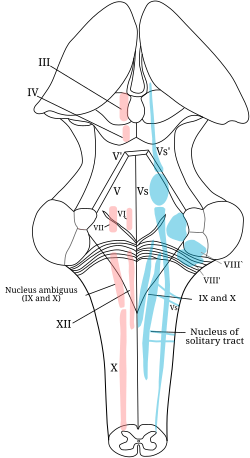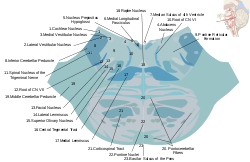Spinal trigeminal nucleus
| Spinal trigeminal nucleus | |
|---|---|
 The cranial nerve nuclei schematically represented; dorsal view. Motor nuclei in red; sensory in blue. (Trigeminal nerve nuclei are at "V".) | |
 Horizontal section through the lower part of the pons showing the spinal trigeminal nucleus (#11). | |
| Details | |
| Identifiers | |
| Latin | nucleus spinalis nervi trigemini |
| MeSH | D014279 |
| NeuroNames | 1732 |
| TA98 | A14.1.04.211 A14.1.05.404 |
| TA2 | 6001 |
| FMA | 54565 |
| Anatomical terms of neuroanatomy | |
The spinal trigeminal nucleus is a
ipsilateral face. In addition to the trigeminal nerve (CN V), the facial (CN VII), glossopharyngeal (CN IX), and vagus nerves (CN X) also convey pain information from their areas to the spinal trigeminal nucleus.[1] Thus the spinal trigeminal nucleus receives afferents from cranial nerves V, VII, IX, and X
.
Anatomy
Structure
The spinal nucleus is composed of three subnuclei: subnucleus oralis (pars oralis), subnucleus caudalis (pars caudalis), and subnucleus interpolaris (pars interpolaris). The subnucleus oralis is associated with the transmission of discriminative (fine)
dental pain, whereas the subnucleus caudalis is associated with the transmission of nociception
and thermal sensations from the head.
This region is also denoted at sp5 in other neuroanatomical nomenclature.[2]
Efferents
This nucleus projects to the ventral posteriomedial (VPM) nucleus in the contralateral thalamus via the ventral trigeminal tract.[3]
Relations
The nucleus is situated lateral to the
nucleus of tractus solitarius.[4]
See also
References
- ^ Brainstem Nuclei Archived 2007-04-13 at the Wayback Machine
- ISBN 978-0-12-547640-9. Retrieved 16 August 2013.
- S2CID 34348758.
- ISBN 978-0-7295-3752-0.
